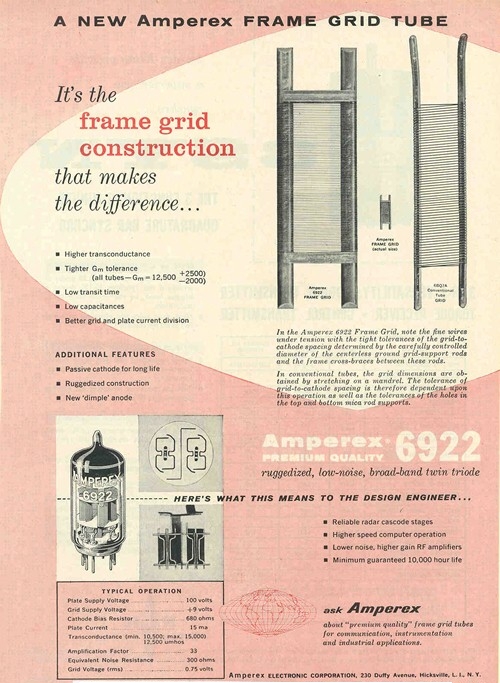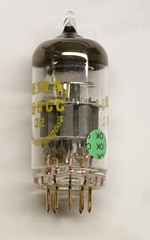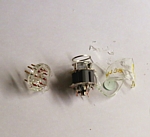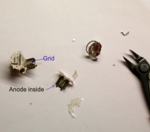Portrait of a Tube
E88CC tube
JACMUSIC. Since 1993. All rights reserved. Copyright note
At first, there was the very successful series of ECC81, ECC82 and ECC83. These tubes often are used randomly by some, by the principle: when it works, it works. However there was a little bit more behind it than just that! Each of those three types have their own purpose in audio applications. ECC83 the typical high gain tube, meaning it will work usually best where high gain is needed. That means at low signal. Which again is a low noise, low microphonics requirement. ECC82 is more the work horse of this series. It resembles mostly the 6SN7, and it is a tube of medium gain only, but for that it has low Plate resistance, and better linearity than ECC83 at high signal swing. It should not surprise you, ECC82 will by itself function in a low signal environment, but it will do not good to the signal to noise ratio. It just comes down to a logical rule: Each tube works best at it's intended application. ECC81 is a product in between. It gives remarkable gain. and can do at reasonable low plate impedance.
So where does E88CC fit it in? This tube is a lower voltage version. It can work nice at 90Volts already. It is a later development, and it features a frame grid, which makes it possible to use an extremely tight grid wire distance, and also makes it possible to bring the grid closer to the cathode. Both these things result in very high transconductance. Into the anode is a ridge, a "dimple" stamped in, which part has a much shorter distance to the cathode, and for this reason is the only part of the anode, carrying plate current. This ridge is shiny polished at the inside, so anode distance is very much better under control as it is with ECC81...83. All in all, this makes what a tube needs. A frame grid by itself is less microphonic than a regular grid, transconductance is very high, gain is reasonable and the tube works already good tat 90V. Lifetime at lower current is very high, and function is till fine. So you see, we have 90Volts tube, which still has all the properties we need. This is the reason, why it was the tube of choice in most tube oscilloscopes for the vertical amplifiers. Some oscilloscopes have a dozen of those inside, because the tube is low microphonics, low noise, good gain and low Rp. All of this in a combination, neither ECC81, 82, or 83 will give. (Not speaking of E83CC / EC803S here, which is a frame grid version of ECC83), E88CC was mass produced, new old stock is still discovered, and a lot of good quality used tubes is around.
A small remark at the end perhaps to those designers who refuse to use tubes the intended way. See of E83CC as a low voltage tube. Using any maximum limits, like all the sheets shows, is possible to choose. But be ready to accept the price for this, which is minimum lifetime and maximum trouble rate. If that is no problem for you, go ahead and stress the Kathode to heater voltage with maximum voltage, in the beloved SRPP circuits (called mu-stage also). Yet if this stage is then also used at very low signal, two things are combines which really do not like each other. The cracking, some 5...10% of the tubes will develop after some 500 hours, indicate rather a poor bad circuit, and not a bad tube.
Some E88CC have a gold grid, meaning the grid wire is gold plated. This is an extra challenge, since plating of such exceptional thin wires, will change the diameter significantly. Moreover, chemical plating is not the right way, this wire at Tesla was thermal plated.
A very rare version of the TESLA E88CC, has also a gold plated frame grid, which in this cas becomes visible from the outside, with it's gold plates ends.
I do not know why they had those two versions, but sure is, the gold plated frame version is many times more expensive and very hard to find.
So we had people saying: I bought your tubes, but I can't see the gold grid! That is why we made a photo series here, and it shows the golden grid wire of a tube with a non-gold grid frame
This is actually a good tube, reason to take it, I have no defective one.
This hurts, to smash a good tube, just to look inside :(
I had no other way.
YOU CAN CLICK ON EACH PICTURE, TO ENLARGE IT
 The glass was kind of hard to crack. Typical broken tube smell comes out. I don't like that smell at all.
The glass was kind of hard to crack. Typical broken tube smell comes out. I don't like that smell at all.
So here the grid becomes visible. Note, the polished surface of the anode inside.
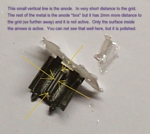 Click this image for more text.
Click this image for more text.
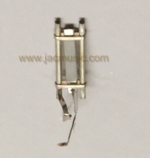 Here is the frame grid with the cathode still inside. Sorry for the low resolution picture, but It was magnified from a normal picture. The next one is made with a Macro lens. So you can see more. With the standard lens, the frame grid wire is hardly visible. The wire is so thin, it appears more like a foil surface. This is so incredible, this is mechanical fine art.
Here is the frame grid with the cathode still inside. Sorry for the low resolution picture, but It was magnified from a normal picture. The next one is made with a Macro lens. So you can see more. With the standard lens, the frame grid wire is hardly visible. The wire is so thin, it appears more like a foil surface. This is so incredible, this is mechanical fine art.
 TESLA Macro Picture. The grid looks a bit burned in the middle, but that was only the camera. The color of the wire is bright yellow. Click here.
TESLA Macro Picture. The grid looks a bit burned in the middle, but that was only the camera. The color of the wire is bright yellow. Click here.
Some frame grids are gold plated as a whole, with others only the grid wire is gold plated. The ones that are gold plated as a whole, have the gold plated bar ends visible. And of course people like to see this extra gold. But it is better? I would say the ones only with gold plated grid wire are better, and probably more difficult to make. That is because gold plating this EXTREMELY thin metal wire is a very difficult, extra step. It is much easier quickly dip the ready made grid in gold plating fluid. Yet they took this extra step to gold plate the wire first. Gold is an emission killer, which is fine for the grid itself, and reason why it is used there. Yet too much gold inside is not good in general for the cathode.
With some tubes however, the grid wire is not gold plated. These are not the best. You can only know by taking some apart, as I did for this photo series, and the ones we sell are all gold plated.
Electro Harmonix 6DJ7 for instance, appeared to have not gold plated wire! Some pictures of the EHX I made, and can be seen here. This explains why EHX 6DJ7 have to much variation of parameters, new out of the box, and why those tubes drift when very hot. Tube dealers will know they are so difficult to match, often impossible to match. Well this explains it.
